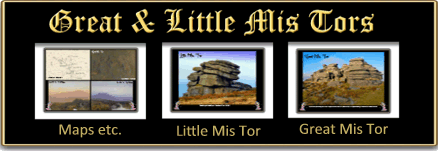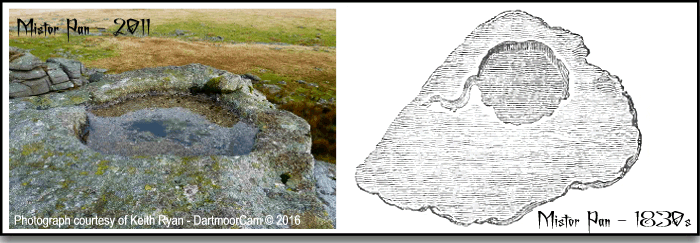
“Great Mistor near the centre stands,
Looming above the dreary lands;
Here heathery wastes, and there the mires,
Surround for miles the rocky spires;
O’er hill and dale and wavy plain
The eye will seek for bounds in vain.”
Rev. E. W. L. Davies – 1863
As Dartmoor tors go Little Mis and her big sister Great Mis are not a lot to write home about. Although Little Mis sits at a half respectable height of 480 metres and Great Mis 538 metres which makes this one the 25th highest of Dartmoor’s Tors. But there are a few interesting facts about the two sisters which make a visit worth while.
The first documented evidence of the tors can be found in the Perambulation of 1240 where the Forest Bounds were said to; “et inde mediam Mystor.” In other words to the centre of Great Mistor. In a later perambulation of 1608 the specified point was to a rock basin on the eastern edge of the tor. In 1867 the boundary line had reverted back to the centre of the tor where an iron bar bearing the letters ‘WB’ and ‘FB’ was placed into the rock. Brewer, p.34. Incidentally this iron marker was one of four placed on various boundary points and in latter years they became known as ‘Cobras‘. But where did the two sisters’ second place-name element come from? The Place-Name Society suggest that due to the tors elevation they could be prone to be enveloped in the infamous Dartmoor mists. Glover et. al. p.195. Page was another proponent of the mist theory when he wrote; “… the etymology is with much greater traceable to the mist which so frequently conceals its rugged brow.”, p.139. Hence Mystor has now mutated to Great and Little Mis Tor. However if one cares to wander down the mythical route then according to some early antiquarians the name Mis Tor has derived from an ancient deity called Misor who was connected to Sol the sun god. This along with the famous rock basin would associate the tor with sun worship – see below.
Probably the best way to approach the two sisters is from a starting point of the Four Winds car park (OS grid ref. SX 5607 7489). On the opposite side of the road is a trackway which leads directly to Little Mis Tor. One early topographical writer described the tor as being; “a small pile of curious rectangular blocks.” He also noted that he had come across a writer in the Sunday Review who called the tor ‘Wain Tor’ because from a distance it looked like a farm wagon although nobody in the locality had heard of this name. Page, p.139.

About 600 metres north(ish) of Little Mis is her big sister Great Mis Tor and in comparison size-wise one can see why. Probably the most noteworthy aspect of the tor which numerous people agree on are the wide-ranging views that can be had from its summit.
“From the rocky breast of Great Mis Tor on a day in spring, those many miles that separated this little mountain from the sea stretched but a span. Crushed by perspective, whole parishes huddled together like the sections of a child’s puzzle map Forests were a thumbnail, large rivers traversed the expanse in bread threads; wide fields appeared but as cubes and lozenges spattered upon this mosaic; while hamlets and homesteads shrank to mere pin points dotted upon the undulations of the land.”, Eden Phillpotts, p.157.
There is even another feature of interest and that is the rock basin on the eastern side of the tor. As mentioned above both the tor and the rock basin have served as boundary points of the forest of Dartmoor. However this rock basin was and is known as Mistor Pan and once again we can see a Druidical connection should the early antiquarians be believed. The idea being that the rock basin would be used as a receptacle in the various rites and rituals of the Druids as they worshiped their gods – may even have been Mistor and the sun. Eliza Bray was one such as can be seen from the description of her visit:
“We returned, with the determination of soon visiting Mistor, which is the nest to the north-east, and which our good shepherd informed us was the most curious on the moor, and that we should there meet what was called Mistor pan: this we concluded must be a Druidical basin of large size.”, p.244.
What intrigues me about the Brays is that considering he was a Reverend and she his wife they spent a lot of time in search of various so-called pagan Druidical landmarks and rock formations. One would have thought that in the 1800s devout Christians would do their best to avoid such things as opposed to bring people’s attention to them?
Another name under which this rock basin goes is the ‘Devil’s Frying Pan’ as not only does the basin’s shape resemble a frying pan but it was said the Devil used or does, depending one one’s beliefs, fry his meals in it. Sadly at some time in the past somebody deemed it fit to break off part of the basin which formed the handle.

About three quarters of a mile to the north of Great Mis Tor is a small stream called the ‘Deadlake’ or ‘Deadlake Well’. The small combe through which it runs are said to be a haunt of the piskies and it is said their magical powers can be found in its waters. Should a party come to the stream then the first person to drink from it can be assured they will be married by the end of the year. Crossing, p.66.
So for an evening stroll a visit to the two sisters would be a pleasant walk which at the furthest point would afford some excellent and rewarding panoramas as well as providing a bit of historical and mystical interest.

Bray. E. 1838. Traditions, legends, superstitions, and sketches of Devonshire. London: J. Murray.
Crossing, W. 1997. Folklore and Legends of Dartmoor. Liverton: Forest Publications.
Brewer, D. 2002. Dartmoor Boundary Markers. Tiverton: Halsgrove Publications.
Gover, J. E. B., Mawer, A. and Stenton, F. M. 1998. The Place-Names of Devon – Vol. 1. Nottingham: English Place-Name Society.
Page, J. Ll. W. 1895. An Exploration of Dartmoor. London: Seeley & Co.
Phillpotts, E. 1909. The Mother. Toronto: William Briggs
 Legendary Dartmoor The many aspects past and present of Dartmoor
Legendary Dartmoor The many aspects past and present of Dartmoor
